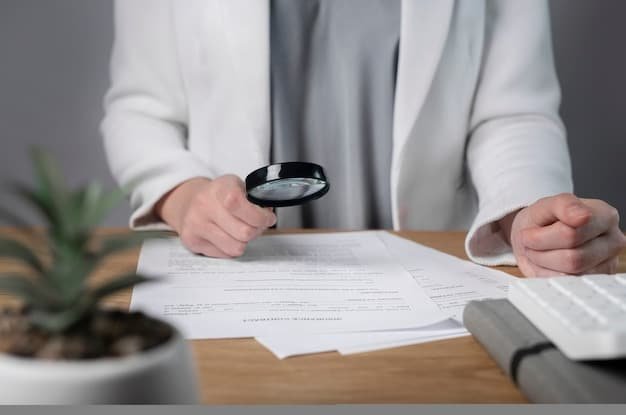Debt Validation: Your Legal Guide to Eliminating Debt in 2025

Debt validation is a legal process that allows you to challenge a debt collector to prove that the debt is actually yours, the amount is correct, and they have the legal right to collect it, potentially leading to debt elimination in 2025.
Are you feeling overwhelmed by debt? The truth is, you might not actually owe all that the debt collectors claim. This The Ultimate Guide to Debt Validation: Legally Challenge and Potentially Eliminate Your Debt in 2025 will show you how to take control and potentially eliminate illegitimate debts.
What is Debt Validation and Why Does it Matter?
Debt validation is a powerful right granted to you under the Fair Debt Collection Practices Act (FDCPA). It allows you to demand that a debt collector prove a debt is legitimate before you pay it. But why is this important?
Many debts are sold from creditor to creditor, and sometimes, information gets lost or misreported along the way. Debt validation ensures you are not paying for a debt that is not yours, has incorrect amounts due, or is being collected illegally.
Understanding the Fair Debt Collection Practices Act (FDCPA)
The FDCPA is a federal law that protects you from abusive, unfair, and deceptive debt collection practices. It provides you with specific rights, including the right to validate a debt.
Key Provisions of the FDCPA
- Right to Request Validation: You have the right to request validation of a debt within 30 days of the debt collector’s initial communication.
- Debt Collector’s Responsibilities: Upon receiving your validation request, the debt collector must cease collection activities until they provide you with the requested documentation.
- Prohibited Practices: The FDCPA prohibits debt collectors from using abusive tactics, such as harassment, threats, and false or misleading representations.
Debt validation is more than just a procedural step; it’s a shield against unscrupulous debt collectors. Understanding and exercising this right can save you significant amounts of money and protect your credit rating.
Initial Steps: Know Your Rights and the Debt Collector
Before diving into the debt validation process, it’s crucial to understand your rights and gather information about the debt collector contacting you. This groundwork will set the stage for a successful challenge.
You need to know what protections you have under the FDCPA and who you’re dealing with. Knowledge is your first line of defense.

Identifying the Debt Collector
Verify the identity of the debt collector. Obtain their name, address, and contact information. Legitimate debt collectors are required to provide this information.
Understanding Your Rights Under the FDCPA
Familiarize yourself with your rights under the FDCPA. This includes the right to:
- Receive written notice of the debt within five days of initial contact.
- Request validation of the debt within 30 days of initial contact.
- Cease communication from the debt collector by sending a written request.
Taking these initial steps puts you in a position of strength. Knowing your rights and verifying the debt collector’s legitimacy are essential for a successful debt validation process.
Crafting Your Debt Validation Letter: What to Include
The debt validation letter is your formal request for proof of the debt. It’s important to write a clear and concise letter, including all necessary information to ensure the debt collector provides the required documentation.
A well-written letter is your primary tool in this process. Being thorough and professional is key.
Essential Elements of the Letter
Your debt validation letter should include the following:
- Your name and address
- The debt collector’s name and address
- The account number associated with the debt (if known)
- A clear statement requesting validation of the debt
Sample Language for Your Letter
Here’s an example of language you can use in your debt validation letter:
“I am writing to request validation of the debt you claim I owe. Under the Fair Debt Collection Practices Act, I have the right to request verification of this debt. Please provide me with the following:”
- A copy of the original credit agreement.
- Documentation showing that you have the authority to collect this debt.
- A payment history of the debt.
Your debt validation letter is a critical document in this process. Clarity, accuracy, and a firm tone are crucial. By including all necessary information and using appropriate language, you increase the likelihood of a successful debt validation.
What Documentation Should the Debt Collector Provide?
When you request debt validation, the debt collector must provide specific documentation to prove the debt is legitimate. Understanding what you should receive allows you to assess the validity of the debt.
The documentation you receive will tell you whether the debt is legitimate. Being prepared to review these documents is key.
Key Documents to Look For
The debt collector should provide the following documentation:
- A copy of the original credit agreement or contract that created the debt.
- Documentation proving the debt collector has the legal right to collect the debt (assignment of debt).
- An itemized statement showing the amount of the debt, including principal, interest, and any fees.
Reviewing these documents carefully is crucial. Look for inconsistencies, errors, or missing information. These could be grounds for disputing the debt.
What if the Documentation is Insufficient?
If the debt collector fails to provide adequate documentation, they are in violation of the FDCPA. In this case, you can:
- Send a follow-up letter explaining why the documentation is insufficient.
- File a complaint with the Consumer Financial Protection Bureau (CFPB).
- Consider consulting with an attorney to explore your legal options.
Knowing what documentation to expect and what to do if it is insufficient empowers you to challenge the debt collector effectively. By taking these steps, you can protect yourself from paying illegitimate debts and ensure your rights are upheld.
Responding to Debt Validation: Your Next Steps
After the debt collector provides the requested documentation, it’s time to review the information and determine your next steps. Understanding what to look for and how to respond is key to successfully resolving the debt.
Your next move is crucial. Knowing your options after receiving validation documents is essential.

Reviewing the Documentation
Carefully examine the documents provided by the debt collector for any errors, inconsistencies, or missing information. Pay close attention to:
- The names and addresses on the documents.
- The account number and the amount of the debt.
- The dates and signatures on the original credit agreement.
Options After Reviewing the Documentation
Depending on your findings, you have several options:
- If the documentation is accurate and complete, you may need to consider payment options or negotiate a settlement.
- If the documentation contains errors or is incomplete, you can dispute the debt with the debt collector and the credit reporting agencies.
- If the debt collector fails to provide any documentation, they must cease collection activities.
Responding appropriately after receiving the debt validation documentation is essential for protecting your rights and resolving the debt. By carefully reviewing the information and considering your options, you can make informed decisions and take control of your financial situation.
Debt Validation vs. Debt Verification: Knowing the Difference
Debt validation and debt verification are often used interchangeably, but they are distinct processes with different requirements and outcomes. Understanding the differences can help you navigate the debt collection process more effectively.
These terms are not the same. Knowing the difference is critical for effective debt management.
Debt Validation
Debt validation is a more in-depth process that requires the debt collector to provide documentation proving the debt is legitimate. This includes:
- A copy of the original credit agreement or contract.
- Documentation proving the debt collector has the legal right to collect the debt.
Debt Verification
Debt verification is a simpler process that involves the debt collector confirming basic information about the debt, such as the amount, the creditor’s name, and the account number.
- Debt verification does not require the debt collector to provide copies of original documents.
Why the Difference Matters
Knowing the difference between debt validation and debt verification is crucial because it affects the level of documentation you can expect from the debt collector. Requesting debt validation provides stronger protection and allows you to challenge the debt more effectively.
Understanding these differences empowers you to choose the right approach when dealing with debt collectors. By requesting debt validation, you can demand comprehensive proof of the debt’s legitimacy and protect your financial interests.
| Key Point | Brief Description |
|---|---|
| 🛡️ Request Validation | Demand proof of the debt’s legitimacy from the collector. |
| 📝 Validation Letter | Send a formal letter requesting validation of the debt within 30 days. |
| ✅ Review Documents | Check provided documents for errors or inconsistencies. |
| 🤝 Negotiate or Dispute | Based on the review, negotiate a settlement or dispute the debt. |
Frequently Asked Questions (FAQ)
▼
The first step is to send a debt validation letter to the debt collector within 30 days of their initial communication. This formally requests they prove the debt’s legitimacy.
▼
If the debt collector doesn’t respond, they must cease collection activities. You can also file a complaint with the CFPB or seek legal counsel.
▼
Yes, but the debt collector must provide validation if you request it. Requesting validation can help build your defense if a lawsuit is filed.
▼
Carefully review the documentation for accuracy. If it’s accurate, consider payment options. If there are errors, dispute the debt immediately.
▼
No, debt validation is not a way to avoid paying legitimate debts. It’s a way to ensure you’re only paying debts that are legally valid and accurate.
Conclusion
Navigating the world of debt collection can be daunting, but with the right knowledge and tools, you can protect your rights and financial well-being. By understanding the debt validation process and asserting your rights under the FDCPA, you can legally challenge debts and potentially eliminate those that are illegitimate, paving the way toward a more secure financial future in 2025.





